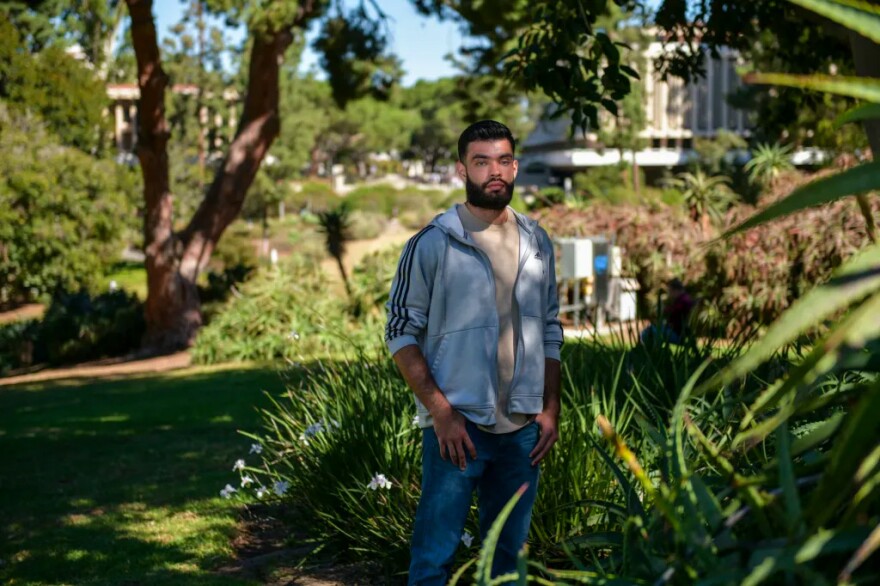As a senior in high school, Ashley Chetla hoped to find a college where she felt supported – not only as a student, but as a Latina. Chetla enrolled at Cal State Los Angeles, drawn to the university’s status as a Hispanic Serving Institution.
“I knew that most of Cal State LA was primarily Latino and Hispanic, and that’s why I actually chose to go there,” said Chetla, now a fourth-year sociology student. “I wanted to feel like I belonged there.”
But Chetla’s time at an HSI has fallen short of her expectations. When she sought academic advising, she said, she was instructed to simply follow the checklist of courses for her major. When she looked into mental health counseling, she said, she could only find two Latino therapists on campus. And she has yet to take a class from a Latino professor.
While the university takes pride in its HSI status, she said, it has a long way to go in serving its Latino students.
There were 174 Hispanic Serving Institutions in California as of the 2020-21 school year, more than in any other state. The designation, first recognized in the Higher Education Act of 1992, allows colleges and universities to apply for federal grants supporting students in areas from financial literacy to academic counseling. The status is purely numbers-based; HSIs must enroll an undergraduate population that is at least 25% Hispanic and have a high proportion of low-income students.
But some researchers, advocates and students say the HSI designation is not synonymous with specifically meeting the needs of Latino students. Because universities aren’t required to use their grants on projects that specifically benefit Latino students, they say, a divide has emerged between universities that simply enroll high numbers of Latinos and those that intentionally serve that population. Some are pushing for the HSI label to take on more meaning.
“We in California have one of the largest sets of HSIs in the country. I would love to say that that is all driven with intentionality, but it’s not,” said Audrey Dow, senior vice president at The Campaign for College Opportunity. “A lot of the designations are really a function of demographic shifts in California.”
The ranks of Hispanic Serving Institutions in California are growing: Currently, HSIs enroll almost 90% of the state’s Latino undergraduate population and have received more than $637 million in federal grants since 1995, according to Excelencia in Education, a nonprofit organization dedicated to supporting Latino students in higher education. Yet inequalities in educational attainment persist, with only 13% of Latino adults in California holding a bachelor’s degree compared to the statewide average of 34%.

white institutions that only recently saw a shift in their demographics, said Sylvia Hurtado, a professor of education at UCLA.
As a result, Dow added, HSIs sometimes lack the intentionality of HBCUs in centering students’ identities and cultures in campus programs, curricula and faculty hiring practices.
“No student at a HBCU doesn’t know that they’re at a HBCU. It is front and center of what they do and who they are,” Dow said. “It’s not that for a HSI; we’ve not changed culture, policy, practice, identity to be a HSI.”
In a nationwide analysis of Department of Education grants awarded to HSIs between 2009 and 2016, 85% of grant proposals failed to include programs that were specifically tailored to Latino student needs.
Lisa Rodriguez, acting director of professional and organizational development at Mt. San Antonio College in Walnut, said some HSI grants are simply intended to strengthen institutions, creating confusion on which populations the funding should serve.
When managing such grants in the past, she said, she was instructed to spend funding in ways that supported all low-income and underrepresented students on campus. But recently, she said, the campus has acted with greater intentionality, using grants to help students develop and run Latino leadership and professional development conferences and teach professors how to meet Latino student needs in the classroom.
“There has been a misunderstanding for years, thinking that we weren’t supposed to just target Latino students, we were supposed to target first generation, low-income and Latino students,” Rodriguez said.
Mixed results
Marcela Cuellar, an associate professor of education at UC Davis who has studied HSIs, said research historically shows that Latino students at HSIs graduate at similar rates to their peers at non-HSIs when accounting for outside factors such as colleges’ resources and students’ levels of high school preparation. The findings, while not surprising, indicate that HSIs are still in need of more resources and funding, she said.
At California State University, 21 of 23 campuses are HSIs. But the widespread designation has not been enough to close equity gaps. For Latino students who entered the university system as freshmen in 2018, their four-year graduation rate was 29%. In comparison, the overall graduation rate for their cohort was 35%, and the rate for their white counterparts was 47%.
Latino students make up nearly 76% of the undergraduate student population at Cal State LA, which has met both HSI eligibility criteria since 2001. But the responsibility often falls on professors to seek out outside funding and develop initiatives welcoming Latino students in the classroom, said Valerie Talavera-Bustillos, a professor of Chicana/o and Latina/o Studies and the equity coordinator of the College of Ethnic Studies.
“The HSI designation will create more of an outcry for students to really know what’s going on.”Alex Verdugo, second-year student, UCLA
She said the university had also supported some initiatives that could pose barriers to Latino students’ success, such as the CSU’s “15 to Finish,” which encourages students to take five classes every semester to graduate more quickly. While the policy sounds effective in theory, it can set individuals up for failure by disregarding the challenges Latino students face as caregivers, first-generation scholars or part-time workers, Talavera-Bustillos said.
“I think the administration has the ideals there, I just wonder if they know how to address these issues, and I wonder if they understand the need to address these issues,” Talavera-Bustillos said.
Chetla said she enrolled at Cal State LA hoping to take culturally-relevant courses and meet with counselors who could empathize with her challenges as a first-generation student. However, she was disappointed to find that her introductory writing courses focused on American history and culture, but excluded the experiences of Latinos in the country.
“Their website and all that is all for promoting diversity,” Chetla said. “They have that diversity, but they don’t know how to target each group.”
In an emailed statement, Cal State LA emphasized its commitment to Latino students, pointing to a $3 million HSI grant awarded in 2020 for educating faculty about culturally-relevant teaching practices and developing academic support services in order to raise graduation and retention rates. The university said it also offers outreach to Latino preschool, grade school and high school students through community programs such as Jumpstart and Go East LA, although these initiatives do not specifically target Latino individuals. The university currently has six therapists on staff who identify as Latinx, a spokesperson said.
Cal State LA’s four-year graduation rate for Latino students stands at 24%, up from about 8% in 2018.
René Vellanoweth, dean of the College of Natural and Social Sciences, said he has seen improvement since his own time as a Cal State LA student. He pointed to another HSI grant the university recently received to provide more field work opportunities for STEM students. While the program and its outreach efforts will serve all undergraduate students, Vellanoweth believes it will naturally target the university’s large Latino population. He added that, for first-generation Latino scientists like himself, field work opportunities can be career-changing, but also expensive and difficult to obtain.
“We believe that when an individual can experience something like being in the field and being immersed in nature … outside of the confines of the university, that this impacts individuals who want to change the community,” Vellanoweth said.
The quest to become an HSI
At the University of California, change is also underway. In 2018, the UC launched its Hispanic-Serving Institutions Initiative, an effort to designate all nine of its undergraduate campuses as HSIs. Hurtado said the push stems partially from a desire to embrace the diversity of surrounding communities – but access to federal grant money can be an important motivating factor as well.
Four UCs have yet to receive the HSI designation.
At an October 20 forum on UCLA’s quest to become an HSI by 2025, Cuellar addressed a crowd of students, professors and administrators.
“How do we define the concept of servingness?” she asked. “What does it mean to serve students?”
Reaching UCLA’s goal will take more than increasing its Latino undergraduate population by four percentage points, Cuellar said.
HSIs must create campus cultures that foster a strong sense of belonging among Latino students, she said, while also spending federal funding in ways that close opportunity gaps among Latino students and their peers.
“We also have seen that there’s been a lot of race evasiveness in some of this funding, as institutions have sought funding for HSIs,” Cuellar said. “They’re not necessarily centering equity, racially conscious practices.”
Armando Guerrero Jr., a former lecturer in UCLA’s Spanish and Portuguese department, said UCLA falls short when it comes to representation of US-born Latinos in the faculty, which is critical for providing students with mentors who have shared experiences of being first-generation students or speaking Spanish in the United States. He said the number of such faculty in his department was reduced significantly after the university declined to renew his and another lecturer’s contracts for the 2022-23 school year.
“(The HSI designation) seems to be a topic that is getting ever more loud at the university. We’re increasing visibility, we’re funding things that we didn’t fund before, and all of that is great,” Guerrero Jr. said. “But there seems to be a disconnect between the message that we have around the vision and how we’re acting at the nitty gritty and the nuanced spaces.”
As of fall 2020, 25% of the UC’s undergraduate population identified as Latino. But only 5.2% of tenured or tenure-eligible faculty at the UC identified as domestic Latinos, according to a university report.
In an emailed statement, UCLA said it highly valued its lecturers but declined to comment further.
Second-year education and social transformation and sociology student Alicia Verdugo, who attended the October forum, called UCLA’s HSI initiative “performative.” But she said the designation may empower students to hold UCLA accountable for creating tangible change – such as using grant money to support low-income Latino high school students in applying to the university.
“At the end of the day, students will fight,” Verdugo said. “(The designation) will create more of an outcry for students to really know what’s going on.”

Luis Soto, a fifth-year urban studies student at UC Irvine, said he initially failed to realize that he attended a HSI because he saw so few Latinos on campus in his first year. He has only received instruction from two Latino professors over the past five years.
Yet, even those limited experiences, he said, have encouraged him to pursue a master’s degree and imagine what he can achieve after college.
“Before I started looking for Latino professors or Latino community here at UCI, I didn’t really know what to do after graduating,” Soto said. “But since I met Latino faculty, Latino professors and been involved with Latino organizations, I’ve made myself a new goal … It makes you strive for more.”
Recruiting more Latino engineers
Some campuses have translated their HSI designations into concrete gains.
When S. K. Ramesh began as dean of the College of Engineering and Computer Science at Cal State Northridge, he saw a need to attract and retain more first-generation, transfer and low income students from Latino communities. The response was the Attract, Inspire, Mentor and Support Students program, which develops transfer pathways in computer science and engineering between CSUN and local community colleges.
Since the program’s start in 2011, the college’s Latino population has risen from one third of students to more than 50%, Ramesh said. In 2019, Excelencia in Education deemed the program an ‘Example of Excelencia’ – a designation that honors evidence-based projects supporting Latino college students.
“We are not excluding anybody,” said Ramesh, who is no longer dean of the college but serves as a professor of engineering there. “But at the same time, we have to be intentional about serving the needs of these students, because these students are coming from communities that are underserved.”
At Southwestern College in Southern San Diego County, the PUENTE project provides year-long mentoring, counseling and English instruction specifically highlighting Latino authors and issues to a small cohort of students. PUENTE boasts a 75% transfer rate – three times that of Southwestern College as a whole — said Guadalupe Corona, director of the office of student equity programs and services. It has a waitlist hundreds long.
The college may turn to HSI grants in the future to help expand the program, Corona said. HSI grants “could help scale initiatives that are successful, which may cost a little bit more money,” Corona said. “But, in the end, the results are much more impactful.”
The California HSI Alliance supports aspiring Latino professors by pairing doctoral students at the UC with Cal State professors and mentors. Funded by the National Science Foundation, the partnership is open to all minority students, but the goal is to prepare a new generation of educators to teach at HSIs.
“The stark gap in college attendance and completion rates for Latino students in the United States is unacceptable.”U.S. Sen. Alex Padilla of California
Jocelyn Ochoa, a participant and chemistry graduate student at UC Merced, said that when she first began her studies, she was the only Mexican student in her graduate program. In her classroom and lab, she gives advice to other Latino students on research opportunities or navigating classes while struggling with English.
“When it comes to TAing, I also like to make students feel comfortable with me, like, ‘I was in your shoes a few years ago,’ ” Ochoa said. “If I can do it, you can do it.”
Defining success
Excelencia in Education awards a Seal of Excelencia to outstanding HSIs across the nation that undergo a robust certification process assessing how they have used data to develop initiatives in areas such as Latino enrollment, financial support and graduation rates.
The seal challenges colleges to assess their concrete impacts on students and sheds light on what thriving HSIs look like in practice, said CEO Deborah Santiago.
“This isn’t just capturing what they’ve done, it’s also capturing where they’re trying to go,” Santiago said. “What we’re assessing is not if they’re perfect, but can we assess intentionality.”
Dow added that the state of California would do well in providing incentives to HSIs for earning the seal. At the same time, national efforts to measure HSI success are underway. U.S. Sen. Alex Padilla of California has proposed a new grant program rewarding HSIs that collaborate with local school districts serving large numbers of Latino students.
“The stark gap in college attendance and completion rates for Latino students in the United States is unacceptable,” Padilla said in a statement. “I introduced the HERE Act to give California HSI’s the resources to be able to provide more equitable access to higher education for Latino students and close that gap.”
Grants can provide much-needed resources for HSIs, which annually receive on average 68 cents for every federal dollar allocated to all other colleges and universities. Yet in order to win them and use them effectively, HSIs need leaders who are focused on supporting Latino students, experts said.
The grants are also competitive, requiring HSIs to beat each other out for limited funding. In California, as more four-year universities have succeeded in receiving HSI grants, Santiago said, some worry that the state’s community colleges — where three out of every four students are Latino — will be left out.
When HSIs flourish, advocates for them argue, the entire state benefits.
HSIs are ranked among the top colleges for economic mobility, and can play a key role in addressing the state’s projected shortage of over one million bachelor’s degrees in the next eight years, said Enrique Murillo Jr., a professor at CSU San Bernardino.
“There is a strong case for increased investment in Hispanic Serving Institutions, so that we can meet the needs of the students where they are, and we can make good on the value of higher education for our individuals, families and communities,” Murillo said.
Yet for that promise to be realized, HSIs must live up to their name, said Melissa Bardo, the associate director of policy and government relations at Education Trust West.
Truly serving Latino students, she said, “means that you anticipate and meet their needs, you affirm the many cultures and languages they bring to campus. Until Latinx students are thriving on your campus, you may be a HSI, but you’re not a true Hispanic or Latinx serving institution.”
Tagami is a fellow with the CalMatters College Journalism Network, a collaboration between CalMatters and student journalists from across California. Reagan is the network’s program manager. This story and other higher education coverage are supported by the College Futures Foundation.






